Page 1 of 1
Identification and Potential Disease
Posted: September 9th, 2019, 8:24 pm
by Nash15
I recently moved in to a house in Apex, NC. I'm in a cookie cutter house neighborhood. The tree in our front yard seems to have a bark issue. I'm not sure, but I don't think the bark is supposed to peel like this. The leaves do look healthy.
I'm hoping someone can help me 1) identify the species and 2) tell me what's wrong with the bark and how to cure.
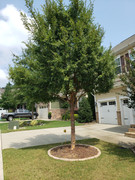
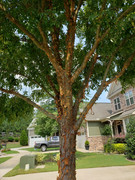

Re: Identification and Potential Disease
Posted: September 9th, 2019, 9:06 pm
by andy10917
You're asking for a species identification without providing a picture (much, much closer) of the leaf structure/pattern. That's begging for a bad guess, and many members won't even guess without that info.
Re: Identification and Potential Disease
Posted: September 10th, 2019, 12:01 am
by TimmyG
Ha! You kill me. You should be thrilled to have a tree with such glorious exfoliating bark. It's all good. Looks super healthy.
My initial guess is
Ulmus parvifolia, a.k.a. Chinese elm or lacebark elm, but as Andy noted, we need some close shots of the leaves. See
Andy's pics for an excellent example of how to photograph a plant for ID. Your pics are actually really good. The set is just missing a good shot of the leaves. Elm leaves, for example, are quite distinct.
Re: Identification and Potential Disease
Posted: September 17th, 2019, 11:00 pm
by TimmyG
Bueller?
Re: Identification and Potential Disease
Posted: September 19th, 2019, 7:22 am
by Nash15
Thank you for the quick response. I have close up pictures of the leaves attached. Sorry for the delay. I appreciate your help.
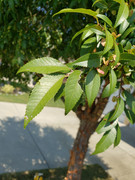
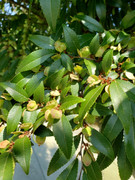
Re: Identification and Potential Disease
Posted: September 19th, 2019, 10:48 am
by TimmyG
Most definitely Chinese elm. Gorgeous tree, and very healthy. Great pics, with seed pods to boot.
Note the asymmetry of the base of the leaves. That's a key characteristic of elm leaves.
Re: Identification and Potential Disease
Posted: September 20th, 2019, 9:53 pm
by Nash15
That's great news! Thank you so much for the help!
Re: Identification and Potential Disease
Posted: October 8th, 2019, 9:46 am
by Nash15
I have another tree that I'm concerned about. This tree is in my backyard with plenty of sunlight. It seems to have lost it's leaves very early and has a lot of white spots on the trunk. Can someone tell me what type of tree this is and if I should be treating it for a disease? Thanks in advance!
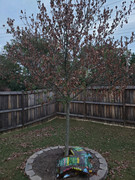

Re: Identification and Potential Disease
Posted: October 8th, 2019, 9:49 am
by Nash15
Here are some more pics
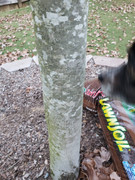
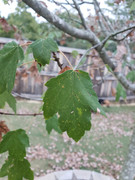
Re: Identification and Potential Disease
Posted: October 8th, 2019, 10:49 am
by TimmyG
Again, the bark looks super healthy on what appear to be some type of
Acer rubrum, a.k.a.
red maple. The white blotches may be the early stages of (non-parasitic) lichens, i.e., just the fungus before the algae. My young maples are always covered in lichens.
Q&A – WHAT ARE THOSE WHITE BLOTCHES ON MY TREE?
As for the leaves, well, that is a bit more difficult to answer, but here's my guess. Red maples are thirsty, thirsty trees. They love to grow in wetlands (which is why I have so many of them). You say you live in Apex, NC. My family in Wake Forest, NC, is desperate for rain. No rain, no water, and your tree is likely just throwing in the towel for this season as a natural defense mechanism and should happily spring back to life next year. That said, if you don't plan to water such a tree during periods of drought, you might want to consider growing a different kind of tree. Maples are shallow rooted, and a super thirsty tree with shallow roots will outcompete grass in a heart beat.
Re: Identification and Potential Disease
Posted: October 8th, 2019, 10:57 am
by TimmyG
Research red maples. If space is limited, make sure it's the tree you want growing there. Red maples are great, particularly this far north. And they're fast growers, which is good if that's what you want, like for shade. My brother has said that one particular cultivar does produce fantastic, reliable fall color down there. I forget which one but could ask. Unfortunately, with the leaves already dropping, you won't have a chance this season to see if it produces good fall color, which is half the reason anyone plants red maples.
Re: Identification and Potential Disease
Posted: October 9th, 2019, 4:14 pm
by TimmyG
Yup, my brother has confirmed that that's what some maples are looking like down there. Water your tree and hope for the best.
Re: Identification and Potential Disease
Posted: October 10th, 2019, 12:35 pm
by Nash15
@timmyG - Thank you so much for the help here. I can rest better this winter knowing that my Red Maple should come back strong in the spring!!
Re: Identification and Potential Disease
Posted: October 10th, 2019, 2:44 pm
by TimmyG
Should. But don't ignore the screaming fact that it's desperate for water now.











